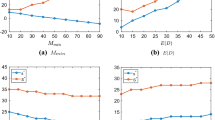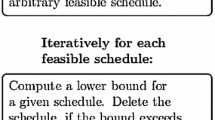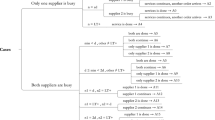Abstract
We study a periodic-review inventory system with multiple capacitated suppliers. These suppliers have different lead times and unit costs, and suppliers with shorter lead times charge higher unit costs. As the optimal ordering policy is unknown and expected to be complicated, we propose a multi-index base-stock (MIBS) policy for the system based on n tailored inventory positions. Orders are placed with each supplier according to a modified base-stock policy. We analyze the policy’s system dynamics and establish separability properties of the optimal policy parameters. We also provide a simulation-based optimization procedure for the policy. Because the procedure involves an exhaustive search across \(n-1\) parameters, we construct a heuristic for computing near-optimal policy parameters. We numerically demonstrate the performance of the MIBS policy and the effectiveness of the heuristic. The results show that the performance of the MIBS policy is very close to that of the dynamic programming policy and that the performance of the heuristic is close to the optimal MIBS policy, with much faster computation. We also explore the performance of the MIBS policy when the number of sources is increased and find that increasing the number of sources means decreasing the average cost, while the marginal returns of adding a supplier diminish. Importantly, given sufficient capacity, by carefully selecting two of the suppliers—often the fastest and the slowest—it is possible to achieve an adequate balance between cost efficiency and responsiveness.


Similar content being viewed by others
Notes
In this article, we use the terms “supplier” and “source” interchangeably.
References
Allon G, Van Mieghem JA (2010) Global dual sourcing: tailored base-surge allocation to near-and offshore production. Manag Sci 56(1):110–124
Arts J, Van Vuuren M, Kiesmüller G (2011) Efficient optimization of the dual-index policy using markov chains. IIE Trans 43(8):604–620
Bohner C, Minner S (2017) Supplier selection under failure risk, quantity and business volume discounts. Comput Ind Eng 104:145–155
Burke GJ, Carrillo JE, Vakharia AJ (2007) Single versus multiple supplier sourcing strategies. Eur J Oper Res 182(1):95–112
Chen Q, Zhao L, Fransoo JCJ, Li Z (2019) Dual-mode inventory management under a chance credit constraint. OR Spect 41(1):147–178
Ciarallo FW, Akella R, Morton TE (1994) A periodic review, production planning model with uncertain capacity and uncertain demand-optimality of extended myopic policies. Manag Sci 40(3):320–332
Daniel KH (1963) A delivery-lag inventory model with emergency. In: Scarf HE, Gilford DM, Shelly MW (eds) Multistage inventory models and techniques. Stanford University Press, Stanford, pp 32–46
Ekici A, Ozener OO, Duran S (2019) Cyclic ordering policies from capacitated suppliers under limited cycle time. Comput Ind Eng 128:336–345
Federgruen A, Liu Z, Lu L (2019) Dual sourcing: creating and utilizing flexible capacities with a second supply source. Working Paper
Federgruen A, Zipkin P (1986) An inventory model with limited production capacity and uncertain demands i: the average-cost criterion. Math Oper Res 11(2):193–207
Federgruen A, Zipkin P (1986) An inventory model with limited production capacity and uncertain demands ii: the discounted-cost criterion. Math Oper Res 11(2):208–215
Feng Q, Gallego G, Sethi SP, Yan H, Zhang H (2005) Periodic-review inventory model with three consecutive delivery modes and forecast updates. J Optim Theory Appl 124(1):137–155
Feng Q, Sethi S, Yan H, Zhang H (2006) Are base-stock policies optimal in inventory problems with multiple delivery modes? Oper Res 54:801–807
Fukuda Y (1964) Optimal policies for the inventory problem with negotiable leadtime. Manag Sci 10(4):690–708
Gijsbrechts J, Boute RN, Disney SM, Van Mieghem JA (2021) Volume flexibility at responsive suppliers in reshoring decisions. Working Paper
Gijsbrechts J, Boute RN, Van Mieghem JA, Zhang D (2021) Can deep reinforcement learning improve inventory management? Performance on dual sourcing, lost sales and multi-echelon problems. Working Paper
Hammami R, Temponi C, Frein Y (2014) A scenario-based stochastic model for supplier selection in global context with multiple buyers, currency fluctuation uncertainties, and price discounts. Eur J Oper Res 233(1):159–170
Hua Z, Yu Y, Zhang W, Xu X (2015) Structural properties of the optimal policy for dual-sourcing systems with general lead times. IIE Trans 47(8):841–850
Janakiraman G, Seshadri S, Sheopuri A (2014) Analysis of tailored base-surge policies in dual sourcing inventory systems. Manag Sci 61(7):1547–1561
Keskin BB, Uster H (2012) Production/distribution system design with inventory considerations. Naval Res Logist 59(2):172–195
Klosterhalfen S, Kiesmüller G, Minner S (2011) A comparison of the constant-order and dual-index policy for dual sourcing. Int J Prod Econ 133(1):302–311
Lester T (2002) Making it safe to rely on a single partner. Financial Times April
Levi R, Roundy RO, Shmoys DB, Truong VA (2008) Approximation algorithms for capacitated stochastic inventory models. Oper Res 56(5):1184–1199
Li Q, Yu P (2014) Multimodularity and its applications in three stochastic dynamic inventory problems. Manuf Serv Oper Manag 16(3):455–463
Manerba D, Mansini R, Perboli G (2018) The capacitated supplier selection problem with total quantity discount policy and activation costs under uncertainty. Int J Prod Econ 198:119–132
Moinzadeh K, Nahmias S (1988) A continuous review model for an inventory system with two supply modes. Manag Sci 34(6):761–773
Moinzadeh K, Schmidt C (1991) An \((s-1, s)\) inventory system with emergency orders. Oper Res 39(2):308–321
Özer O, Wei W (2004) Inventory control with limited capacity and advance demand information. Oper Res 52(6):988–1000
Qi X (2007) Order splitting with multiple capacitated suppliers. Eur J Oper Res 178(2):421–432
Rosenshine M, Obee D (1976) Analysis of a standing order inventory system with emergency orders. Oper Res 24(6):1143–1155
Scheller-Wolf A, van Houtum GJ, Veeraraghavan S (2006) Inventory models with expedited ordering: Single index policies. Working Paper. Carnegie Mellon University. Pittsburgh, PA
Schwerdfeger S, Boysen N, Briskorn D (2018) Just-in-time logistics for far-distant suppliers: scheduling truck departures from an intermediate cross-docking terminal. OR Spect 40(1):1–21
Sethi SP, Yan H, Zhang H (2001) Peeling layers of an onion: inventory model with multiple delivery modes and forecast updates. J Optim Theory Appl 108(2):253–281
Sheopuri A, Janakiraman G, Seshadri S (2010) New policies for the stochastic inventory control problem with two supply sources. Oper Res 58(3):734–745
Song J, Zipkin P (2009) Inventories with multiple supply sources and networks of queues with overflow bypasses. Manag Sci 55(3):362–372
Song JJ, Xiao L, Zhang H, Zipkin P (2017) Optimal policies for a dual-sourcing inventory problem with endogenous stochastic lead times. Oper Res 65(2):379–395
Sun J, Van Mieghem JA (2019) Robust dual sourcing inventory management: optimality of capped dual index policies and smoothing. Manuf Serv Oper Manag 21(4):912–931
Svoboda J, Minner S, Yao M (2021) Typology and literature review on multiple supplier inventory control models. Eur J Oper Res
Veeraraghavan S, Scheller-Wolf A (2008) Now or later: a simple policy for effective dual sourcing in capacitated systems. Oper Res 56(4):850–864
Whittemore AS, Saunders SC (1977) Optimal inventory under stochastic demand with two supply options. SIAM J Appl Math 32(2):293–305
Xin L, Goldberg DA (2016) Optimality gap of constant-order policies decays exponentially in the lead time for lost sales models. Oper Res 64(6):1556–1565
Xin L, Goldberg DA (2018) Asymptotic optimality of tailored base-surge policies in dual-sourcing inventory systems. Manag Sci 64(1):437–452
Zhang VL (1996) Ordering policies for an inventory system with three supply modes. Naval Res Logist 43(5):691–708
Zhang W, Hua Z (2013) Optimal inventory policy for capacitated systems with two supply sources. Oper Res Lett 41(1):12–18
Zhou SX, Yang C (2016) Continuous-review (r, nq) policies for inventory systems with dual delivery modes. Oper Res 64(6):1302–1319
Acknowledgements
The authors are grateful to the Editor-in-Chief, Guido Voigt, the associate editor, and two anonymous referees for their comments and suggestions that have helped greatly improve the paper. The authors also would like to thank Chen Xie, for his helpful discussions. Chaolin Yang is partially supported by the National Natural Science Foundation of China (NSFC) [Grant NSFC-72122012, 72071126, 71771141] and the Program for Innovative Research Team of Shanghai University of Finance and Economics.
Author information
Authors and Affiliations
Corresponding author
Additional information
Publisher's Note
Springer Nature remains neutral with regard to jurisdictional claims in published maps and institutional affiliations.
Rights and permissions
About this article
Cite this article
Yang, C., Huang, D. & Xu, C. Multi-index base-stock policy for inventory systems with multiple capacitated suppliers. OR Spectrum 44, 155–177 (2022). https://doi.org/10.1007/s00291-021-00658-5
Received:
Accepted:
Published:
Issue Date:
DOI: https://doi.org/10.1007/s00291-021-00658-5




